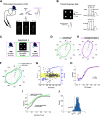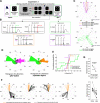Cortically Evoked Movement in Humans Reflects History of Prior Executions, Not Plan for Upcoming Movement
- PMID: 37236809
- PMCID: PMC10324989
- DOI: 10.1523/JNEUROSCI.2170-22.2023
Cortically Evoked Movement in Humans Reflects History of Prior Executions, Not Plan for Upcoming Movement
Abstract
Human motor behavior involves planning and execution of actions, some more frequently. Manipulating probability distribution of a movement through intensive direction-specific repetition causes physiological bias toward that direction, which can be cortically evoked by transcranial magnetic stimulation (TMS). However, because evoked movement has not been used to distinguish movement execution and plan histories to date, it is unclear whether the bias is because of frequently executed movements or recent planning of movement. Here, in a cohort of 40 participants (22 female), we separately manipulate the recent history of movement plans and execution and probe the resulting effects on physiological biases using TMS and on the default plan for goal-directed actions using a timed-response task. Baseline physiological biases shared similar low-level kinematic properties (direction) to a default plan for upcoming movement. However, manipulation of recent execution history via repetitions toward a specific direction significantly affected physiological biases, but not plan-based goal-directed movement. To further determine whether physiological biases reflect ongoing motor planning, we biased plan history by increasing the likelihood of a specific target location and found a significant effect on the default plan for goal-directed movements. However, TMS-evoked movement during preparation did not become biased toward the most frequent plan. This suggests that physiological biases may either provide a readout of the default state of primary motor cortex population activity in the movement-related space, but not ongoing neural activation in the planning-related space, or that practice induces sensitization of neurons involved in the practiced movement, calling into question the relevance of cortically evoked physiological biases to voluntary movements.SIGNIFICANCE STATEMENT Human motor performance depends not only on ability to make movements relevant to the environment/body's current state, but also on recent action history. One emerging approach to study recent movement history effects on the brain is via physiological biases in cortically-evoked involuntary movements. However, because prior movement execution and plan histories were indistinguishable to date, to what extent physiological biases are due to pure execution-dependent history, or to prior planning of the most probable action, remains unclear. Here, we show that physiological biases are profoundly affected by recent movement execution history, but not ongoing movement planning. Evoked movement, therefore, provides a readout of the default state within the movement space, but not of ongoing activation related to voluntary movement planning.
Keywords: TMS; evoked movement; history of movement; motor planning; primary motor cortex.
Copyright © 2023 the authors.
Figures




Similar articles
-
Neural Code of Motor Planning and Execution during Goal-Directed Movements in Crows.J Neurosci. 2021 May 5;41(18):4060-4072. doi: 10.1523/JNEUROSCI.0739-20.2021. Epub 2021 Feb 19. J Neurosci. 2021. PMID: 33608384 Free PMC article.
-
Rapid plasticity of motor corticospinal system with robotic reach training.Neuroscience. 2013 Sep 5;247:55-64. doi: 10.1016/j.neuroscience.2013.05.001. Epub 2013 May 11. Neuroscience. 2013. PMID: 23669007 Free PMC article.
-
Concurrent action observation modulates practice-induced motor memory formation.Eur J Neurosci. 2008 Feb;27(3):730-8. doi: 10.1111/j.1460-9568.2008.06035.x. Eur J Neurosci. 2008. PMID: 18279325
-
Transcranial magnetic stimulation: a non-invasive window into the excitatory circuits involved in human motor behavior.Exp Brain Res. 2020 Aug;238(7-8):1637-1644. doi: 10.1007/s00221-020-05803-0. Epub 2020 Apr 18. Exp Brain Res. 2020. PMID: 32306064 Review.
-
Utilizing movement-related potentials to monitor cognitive rehabilitation in individuals with central nervous system disorders: A review.Int J Psychophysiol. 2025 Feb;208:112485. doi: 10.1016/j.ijpsycho.2024.112485. Epub 2024 Dec 12. Int J Psychophysiol. 2025. PMID: 39674515 Review.
Cited by
-
Fundamental processes in sensorimotor learning: Reasoning, refinement, and retrieval.Elife. 2024 Aug 1;13:e91839. doi: 10.7554/eLife.91839. Elife. 2024. PMID: 39087986 Free PMC article. Review.
-
Corticospinal excitability at rest outside of a task does not differ from task intertrial intervals in healthy adults.Exp Brain Res. 2024 Sep;242(9):2263-2270. doi: 10.1007/s00221-024-06895-8. Epub 2024 Jul 24. Exp Brain Res. 2024. PMID: 39043898
References
-
- Bestmann S (2012) Functional modulation of primary motor cortex during action selection. In: Cortical connectivity (Chen R, Rothwell J, eds), pp 183–205. Berlin: Springer.
Publication types
MeSH terms
LinkOut - more resources
Full Text Sources
